Note: All the data shown here come from a demo built around a fictive electric vehicle brand named BrandX. The purpose isn’t to promote a car, but to demonstrate how the ConsentPlace Conversational Intelligence Dashboard can transform raw conversations into strategic intelligence.
Previous posts on our Dashboard: Part 1/2., Part 2/2
Why Business Leaders Can’t Ignore Conversational Intelligence
Dashboards full of clicks and sales figures only tell part of the story.
What really drives business decisions are emotions, perceptions, and user contexts.
That’s exactly what the ConsentPlace Conversational Intelligence Dashboard delivers — a new lens for leadership.
1 – Main Topics
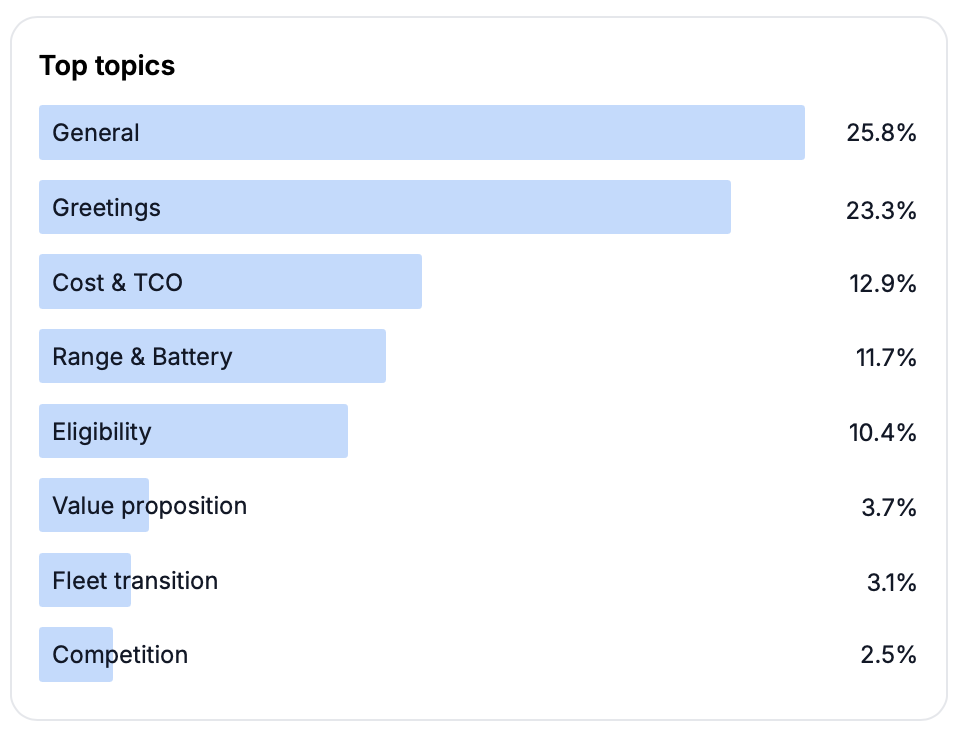
The dashboard instantly reveals what users are talking about most:
- Greetings (25.8%) → trust-building moments
In a Conversational Intelligence Dashboard, “Greetings” refers to the very first interactions users have with the system — messages like:
“Hello,” “Good morning,” “Hi there,” “How are you?”
It may look trivial, but it’s not.
These moments are the temperature check of user readiness and tone — the emotional entry point into the conversation. - General inquiries (23.3%) → context for brand awareness
“General Inquiries” Are Not General at All
In the demo for BrandX, 22.8% of interactions fell under what we call “General Inquiries.”
It sounds vague — but in fact, it’s one of the most valuable indicators of curiosity and brand awareness.
These are the questions that start with “Tell me more…”, “How does it work?”, or “What makes it different?”
They mark the moment of transition from attention to exploration — when users move from passive observers to active participants.
For leaders, “General Inquiries” are early signs of market traction.
They reveal the topics that spark curiosity, the features that invite comparison, and the tone that builds credibility.
A rising share of general inquiries means one thing: Your audience wants to understand you better — not because they’re confused, but because they see potential value.
This is where Conversational Intelligence turns invisible signals into strategy:
* Marketing learns what triggers genuine interest.
* Sales detects when awareness turns into consideration.
* Leadership sees which narratives resonate most deeply with audiences.
Because in a world where attention is fleeting, curiosity is the new KPI of trust. - Eligibility, Cost & TCO, Range & Battery (12.9%, 11.7%, 10.4%) → the real decision drivers. In this post, we’ll focus on those 3.
- Competition, Value Proposition, Fleet Transition → weak signals but strategic risks
👉 For leaders, this is market intelligence: you see what’s top of mind right now, not months later in a survey.
2 – Emotions Are the Missing Layer of Business Intelligence
Plutchik’s Wheel of Emotions transforms raw sentiment into actionable business signals — linking fear to hesitation, trust to conversion, and anticipation to engagement.
For leaders, it’s not just about knowing what people feel, but why they feel it — and how those emotions ripple through buying decisions, loyalty, and advocacy.
By visualizing emotions across every conversation, ConsentPlace gives executives the first real map of human intent within their ecosystem.
Because the companies that read emotions, not just metrics, are the ones that lead markets — not chase them.
And once you can read emotions, you can guide intentions — that’s where Guided Goals take over: turning emotional insight into meaningful, measurable actions that strengthen every brand-user relationship.
Let’s here, focus on these decision drivers: Eligibility, Cost & TCO, Range & Battery
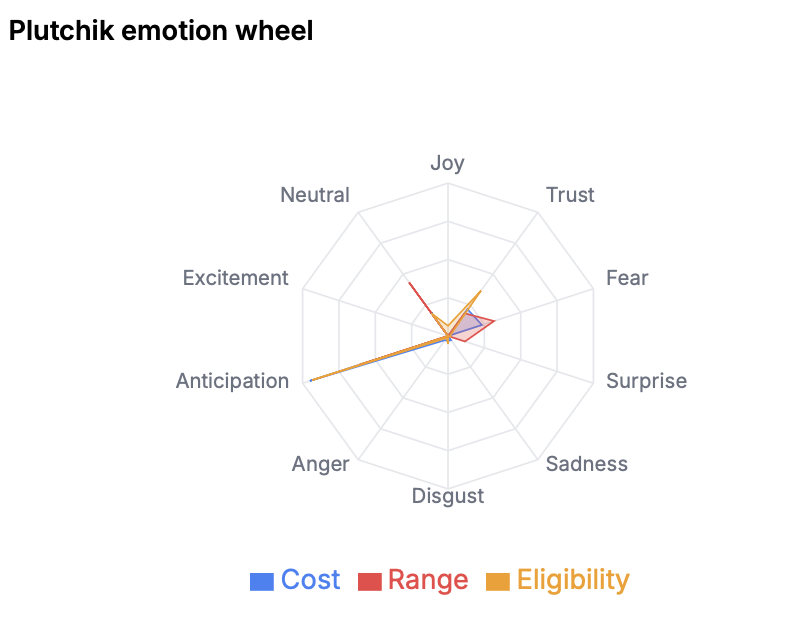
3 — The Power of Profiles: When Data Speaks Human
Every topic has its own user signature — revealing how different audiences think, feel, and engage.
3.1 Cost & TCO: Cost & TCO: When Logic Turns Into Loyalty
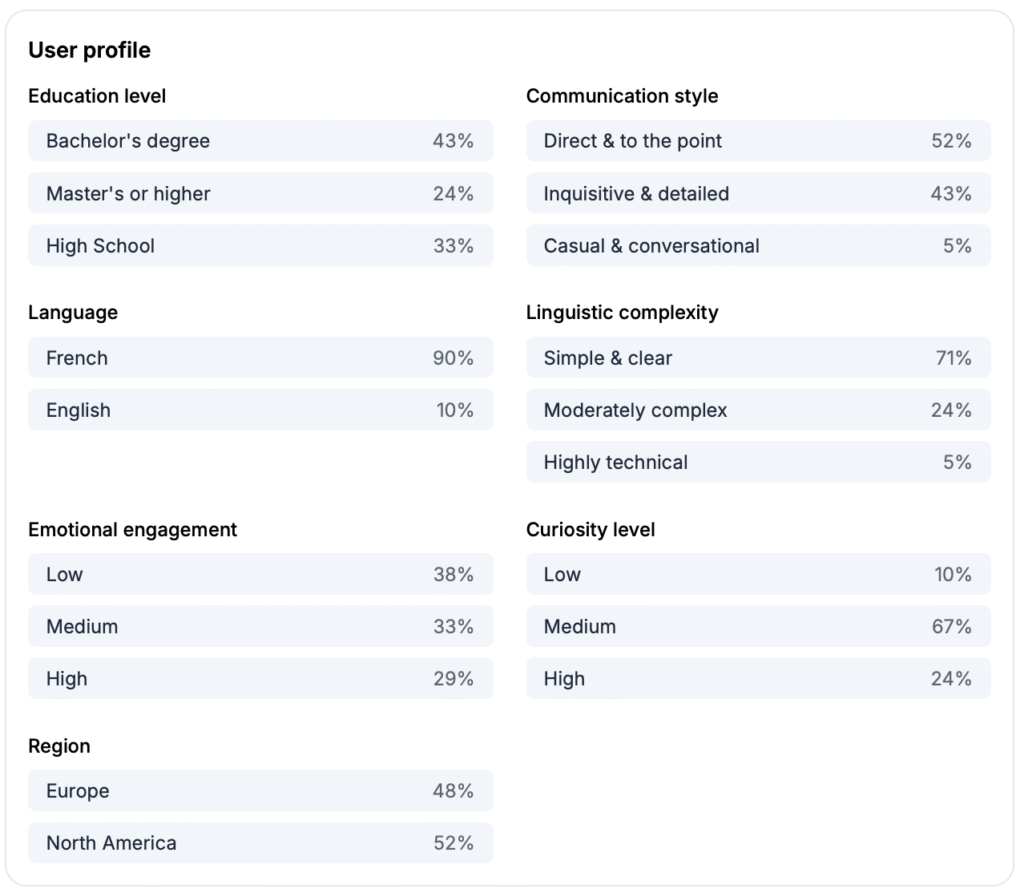
This Cost & TCO profile reveals how financial discussions are not just rational — they are emotional reflections of fairness, trust, and value alignment.
- With 43% holding a Bachelor’s degree and 24% a Master’s or higher, this audience is well-informed, analytical, and expects clarity when discussing cost or ROI. They don’t react to price tags — they respond to transparency.
- 52% communicate directly and 43% prefer detailed reasoning, which makes cost conversations ideal for factual storytelling supported by data, not slogans.
- The French-speaking majority (90%) indicates a user base that values precision in language and nuance — making credibility, tone, and confidence essential in brand messaging.
- The emotional tone is pragmatic: 38% show low engagement, but 33% are medium and 29% high — cost discussions awaken engagement when value is well demonstrated.
- 71% prefer simple and clear phrasing, showing that decision-making thrives on clarity over complexity.
- With 67% at medium curiosity, they’re not impulsive; they’re assessing. This means a good pricing conversation is a guided one — leading the user toward confidence step by step.
- The geographic balance — Europe (48%) and North America (52%) — adds a strategic insight: pricing perceptions vary across markets, but emotional expectations for fairness are universal.
Why It Matters
In B2B and B2C alike, price is never just about cost — it’s about confidence.
Every number tells a story: of value, of performance, of trust.
ConsentPlace’s Conversational Intelligence Dashboard transforms these patterns into real-time insights:
- When curiosity rises, your pricing story is resonating.
- When emotional engagement peaks, transparency has built trust.
- When clarity dominates, conversion follows naturally.
That’s not marketing intuition — it’s quantified emotion.
ConsentPlace turns conversations about price into data-driven proof of brand credibility.
Because when users feel understood, cost stops being a friction point — it becomes the foundation of a lasting relationship.
3.2 Autonomy & Range: When Freedom Becomes the Metric of Trust.
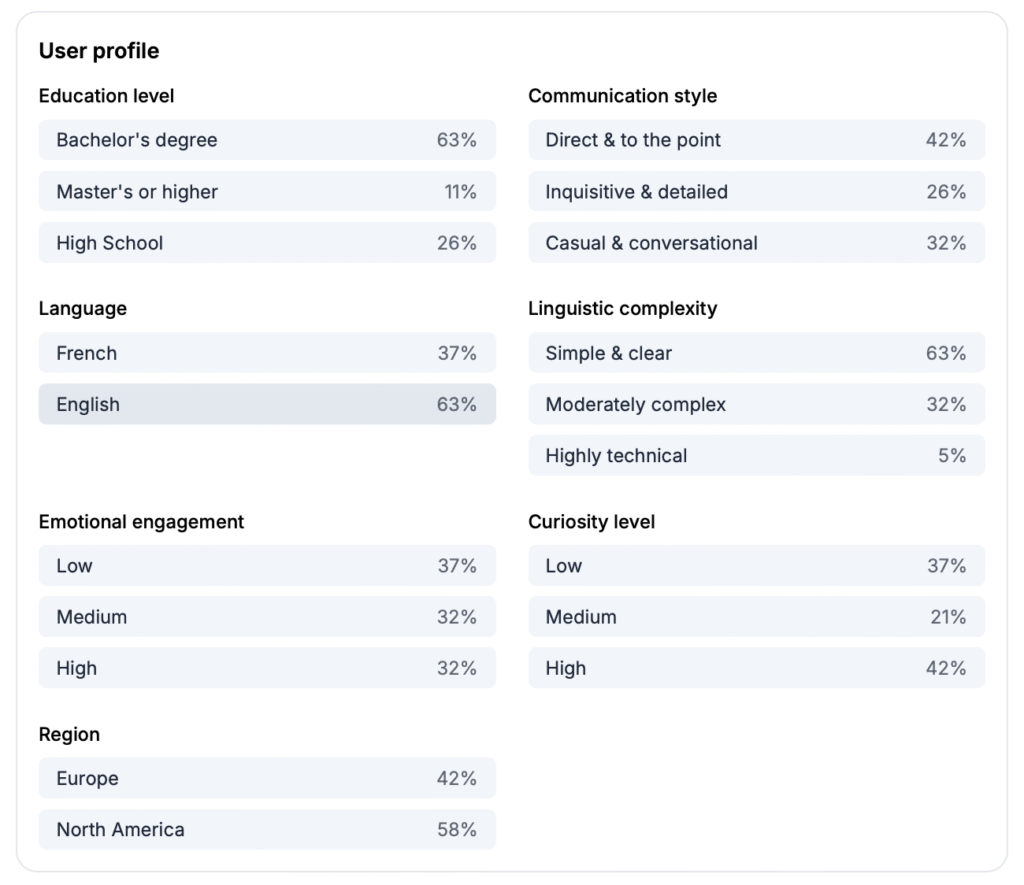
The Autonomy profile reveals more than curiosity about mileage — it’s a mirror of how people evaluate freedom, control, and brand reliability.
- With 63% holding a Bachelor’s degree and 11% a Master’s, this group values clear technical reasoning, not jargon. They want to understand range, not be impressed by it.
- 42% are direct communicators, while 32% keep it conversational — meaning autonomy is not only a spec, it’s a story: they expect the brand to make complex data sound simple and credible.
- The English-dominant users (63%), mostly in North America (58%), reflect a market that links range to independence and lifestyle confidence — not just engineering claims.
- Emotionally, engagement is balanced (37% low, 32% medium, 32% high) — showing that autonomy discussions shift fluidly between technical trust and emotional reassurance.
- Linguistically, 63% prefer simple and clear language, confirming that confidence comes from transparency.
- And with 42% showing high curiosity, autonomy is where discovery drives loyalty — people don’t just ask how far it goes, but what that freedom feels like.
Why It Matters
Autonomy is not only a battery question — it’s a promise question.
When users discuss range, they’re testing whether the brand delivers freedom without compromise.
With ConsentPlace’s Conversational Intelligence, every interaction becomes a signal:
- If curiosity spikes, your autonomy narrative inspires trust.
- If emotional engagement drops, users doubt your realism or consistency.
- If “simple and clear” dominates, your technical storytelling is winning.
That’s the power of Business Intelligence from Conversations — revealing when technical credibility becomes emotional commitment.
ConsentPlace doesn’t just measure how far your product can go.
It measures how far your brand can take people.
3.3 Eligibility: Where Confidence Meets Clarity
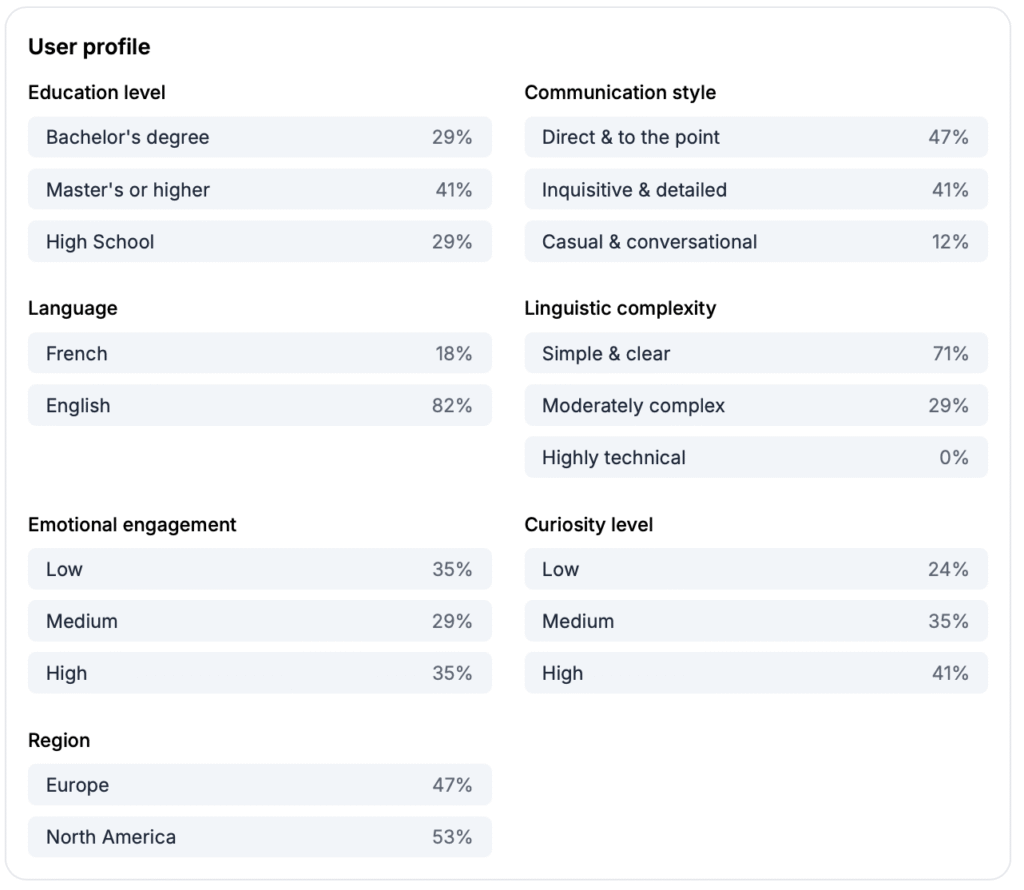
The Eligibility profile captures the audience’s need for reassurance — the moment when potential users want to know “Is this for me?” It’s where clarity, trust, and inclusion converge.
- With 41% holding a Master’s degree or higher, this group is analytical, informed, and expects structure when being guided through eligibility or qualification criteria.
- 47% communicate directly, while 41% are inquisitive, showing they value efficient explanations but won’t hesitate to dig deeper into policy or technicalities.
- The English-dominant audience (82%), largely based in North America (53%), reflects users used to clear-cut, procedural transparency — they don’t want marketing filters, they want reliable answers.
- The emotional engagement is balanced (35% high, 29% medium, 35% low) — a sign that eligibility questions mix rational assessment with personal stake. People want to feel recognized and included, not just evaluated.
- 71% favor simple and clear communication, confirming that technical jargon is the fastest way to lose trust. Eligibility must feel human, not bureaucratic.
- The high curiosity level (41%) means these users are actively exploring options, not passively reading. Every answer is a step toward conversion.
Why It Matters
Eligibility questions are not barriers — they are gateways to belonging.
When a brand explains conditions with empathy and transparency, it transforms what could be exclusion into connection.
With ConsentPlace’s Conversational Intelligence, every eligibility conversation becomes a diagnostic of trust:
- When curiosity is high, clarity builds empowerment.
- When engagement rises, your message resonates as inclusive and transparent.
- When users stay inquisitive, your process feels safe to explore.
This is not just analytics — it’s emotional qualification at scale.
ConsentPlace reveals how users perceive fairness, inclusion, and accessibility in real time.
Because eligibility isn’t about saying who qualifies —
it’s about proving why everyone deserves to understand.
Why It Truly Matters:
ConsentPlace doesn’t just measure clicks or keywords. It maps the human layer of business intelligence — identifying personas, cognitive styles, curiosity levels, and emotional states across every topic.
For a leader, this means one thing:
you finally see who is behind the metrics — not just what they did, but why they felt it was worth doing.
Why This Is Mandatory for Leaders
In boardrooms, leaders don’t need more numbers.
They need clarity:
- Which topics shape perception of my brand?
- What emotions drive those topics?
- Who are the people behind those emotions — and how do they talk?
With this intelligence, leaders can:
✅ Anticipate objections before they block growth
✅ Tailor messaging to real communication styles
✅ Align teams on the emotional drivers behind adoption or resistance
ConsentPlace turns conversations into foresight.
Because when leaders understand what users say, feel, and expect, they don’t just track markets —
they steer them.
#ConsentPlace #ConversationalIntelligence #EmotionalIntelligence #BusinessIntelligence #Leadership #CX #Strategy
Let’s talk?

2 comments